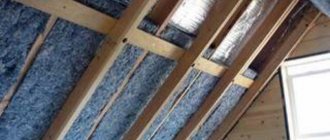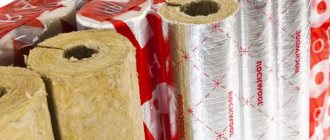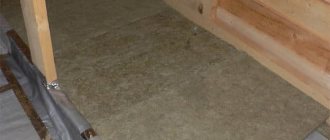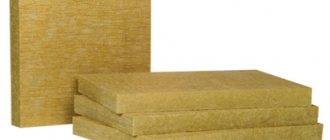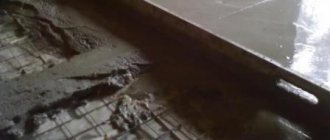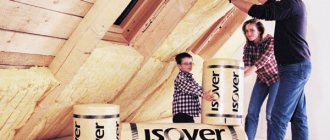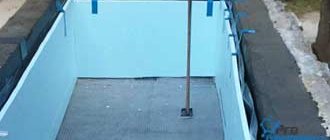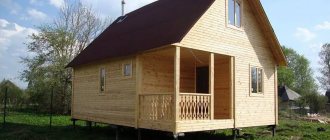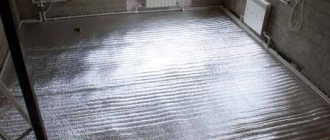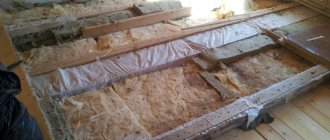Floor insulation is necessary to reduce heat loss both after laying a heated floor system and during installation of the finishing coating. Now there are many types of this useful material on the market, but foil floor insulation is recognized as the leader among them. How to choose the right foil insulation? What are the nuances during installation? We will answer these questions in our article.
Foil insulation for floors
Foil insulation
Foil insulation for floors
The variety of products in construction stores is very large and it is extremely difficult not to get confused among the entire assortment and choose a truly high-quality, effective material, the use of which will not force you to soon redo all the repairs, but, on the contrary, will give you the joy of the fact that it was carried out using high-quality materials .
What is reflective insulation
Foil insulation is a relatively new material on the market. Previously, the category of insulation for floors, walls, and roofs was represented by one single type - mineral wool, which had a lot of disadvantages. This material gets wet, and when in contact with water it loses most of its properties. At the same time, working with it was difficult due to unpleasant tactile sensations, and sometimes dangerous.
Mineral wool
Foil insulation is a two-layer material, most often supplied in rolls, but is sometimes also found in the form of slabs. Layers are represented:
- directly with insulating material, such as polystyrene foam, polystyrene foam, penofol, etc.;
- foil on a layer of insulation, which has certain heat-reflecting qualities.
On a note! Foil insulation has special properties precisely due to the presence of a foil layer. It has the ability to reflect thermal energy and direct it inside the room, preventing it from escaping outside, strictly limiting the area of heat distribution.
Foil floor insulation consists of two layers
Also, material covered with foil does not get wet, which means it also has certain water-repellent properties, although it cannot be used as a waterproofing coating.
Depending on the type of material from which this type of insulation is made, it can be thick or thin, retain heat worse or better, have pores of different sizes, which contain air in one quantity or another.
Polyethylene foam
Where is penofol used?
This material is good for use in insulating rooms, as well as for vapor barrier. It is common to insulate the floor with penofol in a wooden house. After the work is completed, the heat is reliably retained in the room, providing comfort. In multi-storey buildings, it is often common to insulate the floor on the loggia with penofol. It is appropriate to use it when combining a loggia with a living room and want to achieve the effect of a warm floor throughout the apartment.
In addition to wall insulation, penofol is also used for ceilings. They install thermal insulation in the air duct. The material is suitable for use in pipelines. It is even used in the automotive industry, at the stage of thermal insulation of the car body.
Properties of foil thermal insulator
Good insulation with a layer of foil has not only heat-insulating properties. It is distinguished by high levels of sound insulation, is not afraid of temperature changes, protects the room from moisture penetration, and has vapor barrier properties.
Expert opinion
Afanasyev E.V.
Chief editor of the pol-exp.com project Engineer.
A heat insulator with a foil layer is in most cases an environmentally friendly material; it does not harm human health or the environment. It can be safely used in children's rooms, as it is non-toxic.
Penofol
Foil insulation, especially from the category of materials made from penofol or expanded polystyrene, is resistant to mechanical stress - even heavy furniture can be placed on the floor under which such material is laid. The insulation will not lose its properties even in this case.
It is especially important to use foil insulation when installing heated floors. It will minimize heat loss, making the room warmer, and the cost of paying utility bills will be significantly reduced. The working insulating layer itself prevents cold air from outside from penetrating into the apartment, and the foil will ensure that heat is retained inside it.
Installation of penofol inside the house
At the same time, installation of foil insulation is very simple and it does not matter whether it is supplied in rolls or slabs. The material is easy to process - in order to cut a piece of a suitable size, you do not need to purchase any complex equipment. It is enough to have any cutting tool with you.
Attention! If no insulation was used during the installation of the floor covering or heated floor system, this is considered a gross mistake and a violation of the material laying technology.
What does a pie look like for a heated floor?
How to put penofol on the floor
In order to obtain high-quality floor insulation, several conditions must be met:
- The floor insulation is formed from at least two layers, a 4 mm thick foil sheet is laid on top of each other with an air gap of at least 10 mm;
- The top layer of penofol is laid with the foil facing up, and there should be an air gap of 10-15 mm above its surface.
In this case, the thermal insulation characteristics will approximately correspond to industrial continuous insulation with penofol 24 mm thick, or a 40 mm polystyrene foam board, 50 mm mineral wool, 107 mm expanded clay backfill.
In high-quality penofol, aluminum foil can be felt by hand
What tools and materials will be needed
Regardless of the floor insulation installation scheme, you will need to purchase:
- Penofol in roll;
- Adhesive aluminized tape used in laying thermal insulation;
- Construction or stationery knife;
- A metal plumber’s ruler at least a meter long;
- The measuring tool is a construction tape measure and a carpenter's corner.
You will also need a hammer and a sander to eliminate defects on the insulated floor. If you have little experience in cutting penofol, then it will be useful to stock up on regular stationery tape. When cutting the canvas, scuffs often occur, so before cutting the penofol, tape is glued to the line and pressed tightly with a metal ruler.
Important! To install thermal insulation on the finished floor, you will need 40x50 mm wooden blocks. It is necessary to select the most even lumber, without curved surfaces or defects.
Floor preparation
The surface must be cleaned of debris and dust; you can use a vacuum cleaner. No cleaning of the floor is allowed; the surface must be perfectly dry. Defects from pouring the concrete screed must be cut off and the old paint sanded down with sandpaper. Nails protruding from the floor are treated with wood glue and driven in with a hammer.
How to insulate a concrete floor with penofol
Thermal insulation of concrete is carried out only with the help of an additional system of joists or lathing. For example, for a massive concrete floor slab in an apartment or house, the floor insulation process will look like this:
- We cut penofol 4 mm thick so that the floor surface is completely covered with panels end-to-end, without gaps or overlaps. We glue the material onto the concrete with polyurethane varnish. Along the perimeter you will need to make an overlap on the walls equal to double the height;
- We glue the penofol panels at the joints and along the perimeter with aluminized tape;
- Next, we lay a 40x50 block; for a concrete floor, the logs have to be secured with polyurethane foam;
- In the gaps between the beams we cut out and lay thick penofol. We lay OSB or plywood sheets on top.
Most often, penofol is laid in this way on the floor under plywood on unheated areas, on balconies and loggias.
In residential premises, the concrete floor is covered with “hanging” thermal insulation. In this case, the logs are laid directly on the concrete, and penofol “B” is glued on top so that there is an air gap at the top and bottom of the panel. In this way, it is possible to achieve good quality thermal insulation and avoid the accumulation of condensation.
Insulation of a wooden floor with penofol without opening
Ideally, the best thermal insulation option for a wooden floor would be to line it with a metallized panel along the joists with further padding on top of the sheathing slats. But often it is simply not possible to carry out insulation in this way, so the wooden floor is left without disassembly, but simply cleaned and used as a rough floor.
The arrangement of floor thermal insulation is carried out as follows:
- We sew on the beams of the joist beams, while paying attention to the precise alignment of the supporting surface in the horizontal plane;
- We lay the canvas so that the joints between the penofol tapes rest on the wooden beams of the logs;
- We fix the floor insulation with a furniture stapler and seal the seams with tape.
The new floor on top of the thermal insulation should be either plank or made of slats or parquet.
How to properly lay penofol under a warm water floor
Any form of heating requires high-quality thermal insulation of the base, which would block heat leakage through the floor into the ground or foundation. Therefore, foil penofol or an insulator with similar characteristics is always placed under a warm floor. For heated floors, “A-LP” type material is used.
Important! A protective coating on aluminum foil protects the metal from the corrosive effects of any cement-sand or bulk mixtures.
Initially, sheets of foil penofol are glued onto the rough base and the joints are sealed. A layer of thermal insulation is partially applied to the walls and fixed with slats.
Next, you need to lay the mounting mesh or tapes to which the water circuit tubes will be attached directly. As a result, there should be a distance of several millimeters between the pipes and the foil. Otherwise, the thermal expansion of the heating elements will tear the fabric, and cracks will appear in the thermal insulation of the floor.
How to lay foil penofol on the floor under a screed
The most difficult insulation option is considered to be laying polyethylene foam when pouring a concrete floor. In some cases, owners refuse such thermal insulation, considering it ineffective and fragile. All this is correct, if you use the usual version of penofol, for a concrete screed you need a material reinforced with fiberglass or mesh. In addition, penofol can be used as a substrate under a floor screed for sound insulation.
In the simplest version, you can lay penofol of the Super NET brand on a cleaned base in two layers of 13 mm, laying the panels along the edges end-to-end with obligatory gluing with tape. The top layer should overlap the seams of the bottom layer. Next, we lay the reinforcing fiberglass mesh and pour the concrete.
It is better to insulate the floor in the house by laying penofol on joists with 10 mm gaps. The top sheet is sewn up with plywood, the seams are glued with putty, after which concrete can be poured. In this case, the effectiveness of thermal insulation will be noticeably higher due to the complete removal of moisture from the screed without its absorption by the insulation.
Advantages and disadvantages
The main advantage of any insulation with a foil layer is its technical performance, which is significantly increased compared to similar materials, but without a foil layer. However, due to additional production costs and complicated technology, such a heat insulator is more expensive. In general, foil insulation has a lot of positive qualities.
Insulation with foil is significantly superior to conventional heat insulators
Advantages of the material:
- sound insulation;
- safety from an ecological point of view in most species;
- resistance to temperature changes;
- moisture resistance;
- easy installation;
- high thermal insulation properties;
- durability.
Pros and cons of foil insulation
The disadvantages of the material include softness, which prevents the use of foil insulation when laying some soft types of floor coverings, as well as high cost compared to ordinary thermal insulation materials.
Advantages and disadvantages of penofol
Main advantages of the material :
- Low thermal conductivity, the thermal conductivity coefficient of penofol varies from 0.039 to 0.051 W/(m*C).
- The vapor permeability coefficient is 0.001 mg/(m*hour*Pa).
- Thermal reflection coefficient is from 97%.
- Excellent sound absorption.
- Does not absorb moisture.
- Moisture absorption coefficient is less than 1%.
- The material does not melt at high temperatures (up to 110 degrees Celsius).
- Small thickness.
- Strength and durability.
- Easy to install.
- Affordable price.
The density of penofol can be from 25 to 50 kg/m³. When used together with other insulation materials, penofol significantly enhances their properties.
Disadvantages of penofol:
- Insufficient rigidity. You cannot glue wallpaper or paint on top of the penofol layer.
- When attaching penofol, you need to protect the electrical wiring and avoid breakdowns.
- Poor adhesion. It is necessary to use a special adhesive or fasteners for strong adhesion to the surface.
How and where to use insulation with foil
Foil insulation can be used on almost all surfaces of the room, depending on its purpose. They are used for laying walls, roofs, ceilings and floors.
Izover
On a note! Foil insulation for floors is indispensable in rooms located on the first floors.
Where can foil insulation be used:
- when installing a heated floor system;
- to protect floors from penetration of cold from the basement;
- to ensure thermal insulation of walls;
- when installing a roof in a private house;
- when insulating balconies, loggias, verandas;
- when laying water supply and drainage pipes;
- in baths and saunas in order to preserve thermal energy indoors.
Using foil insulation in a bathhouse
In general, the type and method of using foil insulation depends on the room in which the repair work is being carried out, as well as on the purpose of this room, the properties and microclimate of the building, etc.
Which side should you put penofol on the floor?
When laying thermal insulation, the problem of choosing the direction of installation often arises. Lay penofol on the floor with the foil side up. If double-sided material is used, then there is not much difference.
Another thing is how to form thermal insulation; the quality of floor insulation depends on this. You can, of course, simply lay penofol under the linoleum on a concrete floor. With a sheet thickness of 10 mm, the level of thermal insulation efficiency is 1/3 - 1/4 of penoplex or mineral wool 50 mm thick. For a high-rise apartment, or if the house uses radiant heating, this will be more than enough.
In other cases, it is necessary to do combined thermal insulation of the floor; only in this case can the maximum insulating effect be obtained.
Types of foil insulation
| Photo | Name | Rating | Price | |
| #1 | Expanded polystyrene | ⭐ 96 / 100 | More details | |
| #2 | Polyethylene foam | ⭐ 98 / 100 | More details | |
| #3 | Mineral wool | ⭐ 81 / 100 | More details | |
| #4 | Basalt insulation | ⭐ 87 / 100 | More details |
In general terms, it is clear what properties a heat insulator with foil has, however, depending on the type of material, they may differ slightly.
Expanded polystyrene
It is a rather voluminous and thick sheet of material with a layer of foil on one of the surfaces. It is produced using complex technology, during which individual polystyrene granules are fused into a single whole. As a rule, it is installed where there is high humidity and significant mechanical impacts on the floor covering are possible. Most often - when installing a water heating system.
pros
- durable material that is not subject to rotting;
- not afraid of fungus and mold;
- does not lose its qualities during sudden temperature changes ranging from -180 to +180 degrees.
Minuses
- This material is used only for installing a thermal insulation layer on the floor.
Foiled polystyrene foam
Polyethylene foam
Rolled material with a thin aluminum coating on one or both sides. The thickness of the heat insulator varies from 2 to 10 mm. It is usually used to insulate floors and walls, sewers or ventilation shafts. Interestingly, foamed polyethylene is also used in the shoe industry - insoles are made from it.
pros
- easy to install;
- has low weight;
- often equipped with an adhesive layer on one side, which simplifies its attachment to surfaces.
Minuses
not detected.
Foamed polyethylene foil
Specifications:
- specific gravity of a coating with a thickness of 5 mm – 60 kg/m;
- thermal conductivity – 0.038 W/(mK).
Foiled polyethylene foam includes penofol, ecofol, isolon and other materials.
Most often, penofol (ethylene foam) is used for installing floors. This material, depending on its qualities and characteristics, can be divided into 4 types:
- A – covered with foil on only one side, a classic and familiar material. Rarely used in rooms with high air humidity, but can be installed in such rooms when laying a layer of waterproofing;
- B – has a foil coating on both sides, a very dense type of heat insulator. No additional installation of a moisture-protecting layer is required;
- C – material that has a foil layer on one side and a self-adhesive layer on the other;
- ALP is a heat insulator with one layer of foil, but laminated with polyethylene. Used when installing an electric floor heating system;
- R – one side is embossed, the other is smooth;
- Super NET - among all types, has the maximum thermal insulation performance, can be used for many years and not lose its properties.
Penofol can be of several types
On a note! A good insulation material is polypropylene film, which has metal inclusions, due to which heat is evenly distributed over the entire surface of the floor and is retained for a long time.
The material is self-adhesive. Peel off the film
Polyethylene foam foil
Mineral wool
A type of insulation familiar to many. Mineral wool with foil is sold in the form of rolls or slabs and is usually used for thermal insulation of roofs, floors in bathhouses and on loggias or balconies. The foil layer is applied only to one side of the material. The thickness of mineral wool can vary from 5 to 10 cm. The base is a basalt slab or fiberglass. When installing even in non-residential premises or outside the house, it is recommended to cover it with film.
pros
- low cost.
Minuses
The material is far from safe for health, and it is not worth using such insulation in an apartment. It can cause the development of respiratory tract diseases, as it releases a dangerous substance – phenol – into the air.
Mineral wool foil
Basalt insulation
This type of insulation belongs to the category of materials based on mineral wool. It is used in the construction of stoves and fireplaces due to its non-flammability. Used for thermal insulation of walls and roofs, floors between floors.
pros
- not afraid of exposure to external environmental factors;
- not flammable;
- ease of installation.
Minuses
- increased thermal conductivity when wet.
Foil basalt insulation
Does it work or not?
The foil underfloor heating is the most controversial. There are two opposing opinions. One is for using this material. Its supporters claim that there will be significant savings on losses “to the floor” due to the reflection of heat back.
Even most of the diagrams are drawn using foil under the heated floor heating element
Second opinion - you need thermal insulation, put 50 mm EPS. Foil or 2 mm backing with a shiny floor will not help with this. And reflection in a solid body does not work, so it makes no sense to talk about reflected heat in the thickness of concrete. Let's take a closer look at both points of view, and then look at the test results.
How can foil in a screed help?
As you know, radiation can be reflected from shiny surfaces. The heat in the screed is also partially transferred by radiation. By turning back at least some of the downward rays, you can reduce heat loss. This is what the foil underlay for heated floors is designed for. It is placed on the base, and on top are pipes with coolant. That part of the thermal radiation that is directed downward will be reflected and returned to the room. In theory, losses should decrease.
Reflective insulation: is it suitable for underfloor heating?
This is exactly what sellers of foil materials say. Many people decide that the costs are not too high, and a possible reduction in the payment for coolants warms the soul. Moreover, the screeds (the preparation and the actual screed with the heated floor) still need to be “untied.” So you can use not just plastic film, but foamed polyethylene with lavsan coating or foil.
When installing a film heater, a substrate must be laid underneath it. As a backing, you can use foil material or any other type of thin elastic material (technical cork, pine backing, etc.). Film heated floors are most often made under laminate, and it has a drum effect. The main task of the substrate is to level out micro-irregularities in the base and reduce the drumming effect. Foamed polyethylene copes with this task well. And the foil film helps retain heat. These are again the sellers' arguments. Sounds tempting.
Arguments of opponents
Let's discuss the second opinion, which is that foil, foil backing or any other shiny material in a screed cannot work. For now we are talking about the possibilities of reflecting radiant heat. Yes, shiny surfaces reflect radiation (light and heat, in particular). But for this, in front of the reflective layer there must be a layer of material transparent to this radiation. So, when insulating walls/ceilings, an air gap of several centimeters is left between the foil layer and the finishing. In this case, no questions arise about its effectiveness. There is no mention of a gap in the screed. Or rather, not quite like that.
Before installing the heating element, a foil backing for the heated floor is laid
Theoretically, such a gap exists if a layer of foil or other protective material is filled with a transparent polymer. This was done to protect the foil from destruction in the concrete layer. Simply, the gap size must be no less than the length of the reflected wave. And it is a fraction of a millimeter. So, in theory, the protective layer of polymer is sufficient to meet the reflective conditions. But is it possible to say that reflected rays can significantly affect the overall heat loss...
In the thickness of concrete, heat exchange by radiation constitutes a very small proportion. There is no specific data, but this is not even 1%, but less. However, we will assume that one percent of the heat is transferred by radiation. Let half be directed downwards (in reality less). This is 0.5%. Not everything that is directed downward will be reflected either. Let it be half too. Total, this is 0.25%. That is, no more than 0.25% of heat can be returned. With underfloor heating costs of 5,000 thousand, the savings will be 12.5 rubles per month. Not funny.
Foil insulation is not uncommon. But does it make sense to put it on a warm floor?
Plus, the most popular (because the cheapest) material in this category is polyethylene foam with a shiny coating. It is suitable for insulating walls and ceilings. And in a screed or under a laminate, under load it wrinkles. There is no trace left of the “foaming”. All that remains is a thin layer of polyethylene and a film on top. So it cannot work as insulation in a screed. In general, it is difficult to say whether reflective insulation works in a heated floor design.
What do experiments show?
All disputes and statements are just theories and attempts to apply existing knowledge to an unexplored area. No one has yet carried out a “pure” experiment that would clearly prove whether foil works or not in a heated floor design. There are a couple of experiments carried out by “ordinary users” who wanted to find out for themselves the feasibility of using a foil backing for a heated floor.
First experiment
The first testing was carried out with a heating film on which the laminate was laid. One part uses Folgoizol 2 mm thick with foil and a protective coating, the other uses foamed polyethylene of similar thickness, but without lamination. Readings were taken using a pyrometer. As usual, in such devices the temperature is displayed in color. The darker the orange, the warmer it is. This model also had the ability to display results in the form of a table. Data in the photo.
Results of measuring the temperature of a heated floor with and without foil
According to these data, it turns out that there is a difference in the temperature of the floor with the same insulation with and without foil. It is 1.5°C. Not much, but quite noticeable. Just like with our hand, we feel the difference between the forehead of a healthy person (36.6) and a sick person (38). Approximately the same difference will be felt by the legs.
Checking the work in the screed
The second experiment was carried out by simulating a water heated floor. Three pieces of screed 35 mm thick were poured onto a concrete hollow slab. One area was without insulation, the second was using Folgoizol. This is 2 mm polyethylene foam with a foil coating. The third is with foamed polyethylene 5 mm thick. A coolant pipe is passed through all three ties. To level out the temperature difference, the speed of movement was chosen to be high, which minimized the difference.
Foil element for a warm water floor: works or not
If you look at the graphs, it turns out that the temperature of the screed with foil is 1.5 degrees higher than without it. That is, this experiment shows approximately the same difference as the previous one, but under different conditions.
conclusions
Based on these two different experiments, it turns out that practice shows: foil underfloor heating works. It’s not clear why, but the reflective layer makes a difference of about 1.5°C, which is pretty good.
To be fair, it must be said that the experiments are not entirely “clean”; there are flaws in the organization. But there are no similar refutations. Believe them or not is your business. Whether to use a foil underlay for a heated floor or not is also your choice. There are no final conclusions either in favor or in denial. So you make the decision yourself.
This definitely works where there is an air gap
The only thing that is known for sure is that aluminum foil is not poured into the screed. It turns into dust in a couple of months. But foil or its spraying is more effective than lavsan spraying (also shiny). And to prevent the foil from corroding, it is protected with a layer of polymer. So if you decide to use a foil underlay for a heated floor, choose one with foil and a protective film on top of it.
So what to do?
Heat loss when heating the floor can be reduced by using insulation of appropriate thickness (50-70 mm optimal). And two millimeters of foil insulation (even if the reflection works) will not affect the picture too much. Even if you take a centimeter foil insulation. Under the weight of the screed, it is compressed into a couple of millimeters of hard polymer with fairly good thermal conductivity. So it will not be able to significantly reduce heat loss.
What is the secret of foil materials
Don't want to warm the planet or your neighbors below? Place full-fledged normal insulation under the screed with heated floors. EPPS performs best. It needs 50-70 mm. Does the idea of reflected heat and savings due to this warm you up? Attach foil to the EPS and cover with film. The effect will be the same.
Do you need a foil backing for a film heated floor? According to the technology, it is necessary to lay a substrate under the heating film that will compensate for micro-irregularities. Ideally, a technical cork, but foamed polyethylene will also work. If you don't really need to reduce heat loss, it's not bad.
Nuances of fastening and installation
When laying foil insulation, you may need the following tools and materials:
- nails with large heads;
- stapler;
- hammer;
- construction tape.
When installing insulation with foil, it is important to avoid the mistake of laying the material with the shiny side down. In this case, the material will not perform its heat-reflecting functions. The foil side must “look” into the room in order to be able to return thermal energy to the room.
An example of laying lag on foil insulation
Advice! You can leave a small air gap between the insulation and the floor covering. Then the floors will be even warmer.
It is also important to remember that the insulation does not overlap. The sheets should be placed end to end and secured with tape or nails, depending on the type of base. Insulation with an adhesive layer may not be additionally fixed, but it is still recommended to secure it with fastening materials. All joints after laying the material are taped.
Thermal insulation for heated floors
Work on laying insulation can be dry or wet. In the second case, the material will be filled with concrete screed. In the first one, it is advisable to install an additional waterproofing layer.
Recommendations and common mistakes
The main mistake that all beginners make is when trying to tightly tie penofol and screed. Concrete will certainly shrink, as a result of which part of the foil may be damaged. Therefore, the contact surface between concrete and penofol is often additionally covered with film. In this case, even with repeated heating and cooling of the thermal insulation, the penofol does not wrinkle, and the floor remains intact.
Gas in the open pores of penofol can cause cracks.
The second serious mistake is related to the use of nails and screws. With their help it is convenient to attach logs, but you cannot pierce the foam foam sheet. Under load, the self-tapping screw can work like a knife, and over time, part of the insulation will be shredded into noodles. You just need to glue or secure with tape.
Roll material laying technology
Step 1. The material produced in a roll must be laid on a surface cleared of debris. The base is swept, washed if necessary and dried.
Preparing the base
Step 2. The insulation is cut into pieces of the required length and size.
Cutting foil insulation
Step 3. The material is leveled over the surface of the room.
The insulation is leveled over the surface
Another photo of the process
Step 4. In small rooms, the insulation is attached along the walls and across with wooden blocks. Its individual sheets are glued together with tape.
The insulation is attached using bars
The process of installing bars
Step 5. If the floor covering allows it (it is quite dense), then lathing is done on top of the laid insulation. This makes it possible to create an air gap.
Creating a sheathing
Next, the floor is covered with a finishing coating or filled with concrete screed; work is also carried out on the installation of heated floors, if necessary.
Warm floors are a serious cost item during renovation, so it is important to accurately calculate how much and what materials will be needed. To ease your labor costs, we have prepared special instructions telling you how to calculate a heated floor - water or electric. Online calculators included. And in the article “ What do you need for a heated floor? » you will find a complete list of everything that may be needed during installation.
Video - Laying roll backing
Insulation with a layer of foil is a good option for high-quality thermal insulation material. It will serve for many years if you choose it correctly in accordance with operating conditions, as well as with proper installation. It’s easy to avoid mistakes; the main thing is to carefully familiarize yourself with all the nuances of using the material.
* * * * * * *
For purely practical reasons, and also as an example of the effectiveness of using foil insulation, especially when combined with other thermal insulation material, below is a calculator for calculating the insulation of a balcony. Since it makes no sense to consider the floor on a balcony or loggia separately, the calculator allows you to make calculations for the entire room, for each of the surfaces that require thermal insulation.
Brief explanations on how to use the program will be given below.
Rules for laying foil backing
Foil underfloor heating can be in rolls, mats or slabs. When laying, this coating must be joined both in length and width. In order for the connections to have the same properties, the fragments are glued together with special metallized (foil) tape. You must glue carefully, avoiding gaps, try to make the fit as precise as possible, without gaps.
When laying thin rolled foil material in a screed, the strips may overlap one another. The size of this “overlap” is at least 10 cm. This joint is glued twice on one side and on the other. We make cross connections according to the same rules.
When laying mats or slabs, they are joined close to one another, then glued with the same shiny tape. Some manufacturers make a lock along the edges of the slabs, which reduces the possibility of heat leakage through the joints. Despite this, we also glue the locking joints with tape. This makes it much more reliable.
Source
Manufacturers and prices
To insulate floors, not only Penofol is used, but also other types of insulation, so we will present the most popular products from famous brands.
| Manufacturer | Features of the heat insulator | Price, in rubles |
| Rockwool | Basalt wool with foil, supplied in packs of 8 sheets, which can cover 4.8 m2 | 700 |
| Izolon | Foamed polyethylene, supplied in rolls. Price per meter of material, 3 mm thick | 200 |
| Penofol | -//- | 100 |
| Ecofol | -//- | 70 |
| Porilex | -//- | 50 |
| Xotpipe | Basalt wool, supplied in rolls. Cost per 1 meter. | 100 |
Thermal insulation with foil has become very popular; owners of private houses have already appreciated its high performance characteristics. It has proven itself to be a good thermal insulation material that does not allow cold air and dampness to pass through, and also protects the home from heat loss by reflecting infrared rays into the room.
About the material
Foil Penofol is produced on the basis of foamed polyethylene and aluminum foil. It can be two-layer, when the thinnest aluminum sheet is glued on one side, or three-layer, when the foil is fixed on both sides. The connection of metal and plastic is carried out using a thermal method - heat welding.
The base, polyethylene foam, can have different thicknesses and densities, which affects the technical parameters of the product. The thickness of the foil is 12-30 microns, it only affects the strength under mechanical stress or compression.
Important: there are many fakes on sale. Instead of foil, metallized film is used. You can tell the difference with a lighter: foil does not burn.
The main purpose is an additional heat insulator with sound, heat, steam and waterproofing properties. Can be used as a vapor and wind insulation material when insulating facades.
Penofol foil insulation is used in many sectors of the national economy. The requirements for the material are different. Manufacturers took into account the wishes of users and offered the building materials market several types of insulation. To designate varieties, a classification by type with a letter designation from the Latin alphabet was used.
Type A. This type of foil material is considered classic - foil is only on one side of the insulation (one-sided). The main purpose is additional insulation using mineral wool with simultaneous vapor barrier.
Type B. In construction, situations often arise when thermal insulation is needed on one side of a building’s structural element, and vapor barrier or wind protection is needed on the other side. In these cases, an additional sheathing is installed and a vapor barrier membrane is attached to it. I solved the problem by applying a layer of foil to the second side of the material.
The result was insulation with double-sided foil. It is used on all structural elements of a house or apartment: floor, wall, roof. You can most clearly see how type B insulation works using the example of a roof. From the attic side it prevents heat from escaping. And from the outside it protects the insulation and the interior space from steam and wind.
Type C. Foil insulation is secured with staples or screws, which is very difficult to do on reinforced concrete walls. Applying a layer of glue to the foil-free side made the task easier. The type of insulation is designated “C”, which means self-adhesive. The structure of such “Penofol” is shown in the photo below.
These are the basic types of insulation. The insulation of individual objects and structures with foil Penofol gave birth to several more varieties of the material.
Type R. To give a more beautiful appearance, with open insulation inside buildings, the surface of the polyethylene foam on the foil side is embossed. The relief pattern does not affect the technical and operational characteristics, but protects the insulation from the outside from mechanical damage. Therefore, type R is similar to type A.
Type M. Hidden under this marking is foil insulation with a relief on the side opposite to the foil.
Type A-LP. Aluminum is afraid of aggressive environments. For example, when insulating calf barns and barns with foil material, the foil is corroded within 3-5 years. They found a simple way out of the situation: they covered the aluminum with plastic film. Pasted.
Features and main differences
There are several methods involved in heat transfer:
The task of any insulation is, if not to completely break the heat transfer chains, then at least to reduce their strength. A preventative method is used for this. In this case, the effectiveness of thermal insulation is affected by the thermal conductivity and thickness of the material. The lower the first indicator and the higher the second, the warmer the house will be.
In the case of Penofol, the principle of operation of a thermos is used - heat rays are reflected back into the room by a layer of foil. This method of insulation is called reflective.
Don’t forget the porous structure of polyethylene foam - it works as insulation using the preventive method. The complex method of thermal insulation makes any comparisons of Penofol with other types of insulation incorrect.
The only indicator that will allow you to more or less objectively evaluate and then compare foil-coated Penofol with other insulation materials is the heat transfer resistance coefficient. So, for “Penofol” foil-coated on both sides with a polyethylene foam thickness of 4 mm, the heat transfer resistance indicator is 1.2-1.23 m 2 * o C/W. The given parameter corresponds to a layer of basalt wool 8-8.5 cm thick.
Use in a heated floor system
The combined use of these two insulation materials allows you to increase the amount of stored heat by 20%.
The method for laying ponofol with heated floors looks like this:
- Cover the cleaned surface with a concrete screed mixed with expanded clay and let it dry completely;
- Lay the sheets of penofol (“A”, “C”, “Alp”) with the foil facing up. Make sure that there are no gaps between the pieces; overlap them by 10-15 cm near the wall;
- Seal the joints with reinforced tape, place heating elements (water tubes, electrical cables) on top;
- Place a metal mesh on top, pour a screed on top to level the surface;
- When the solution has hardened, cut off unnecessary pieces near the walls. To speed up the drying process, turn on the heating elements briefly. Be careful, at too high temperatures the screed can quickly crack;
- Install the selected floor covering.
Pros of using penofol
It is important to know all the positive aspects of using this material:
- It can be laid in rooms where it is damp, for example, in a cellar (basement). When laying, separate membranes for waterproofing are not required.
- In addition to the fact that you get a coating that retains heat well, sound insulation is a bonus. This quality of material is relevant for multi-storey buildings with noisy neighbors.
- Penofol is recommended to be used in combination with other heat insulators, then its properties only increase. A good example is the use of the desired material in baths. A layer of aluminum foil in the steam room helps keep the temperature high.
- Even at high humidity and high temperatures, penofol will not emit fumes that could harm human health.
- The material is considered thin, which is good when laying it on the ceiling. The height of the ceilings practically does not change; other insulation materials make the room visually smaller, since they recede a few centimeters from the ceiling.
- Penofol is offered for sale in rolls. It can be easily cut and you can lay it down in a short period of time.
- It is often used in areas where there is a high fire hazard. The material does not burn, which makes it irreplaceable.
- For private houses, it is used to insulate the basement floors, and also because mice do not gnaw on it.
Insulation of concrete floor
Typically, a cold base must be insulated using an additional heat insulator.
This is done using the following technology:
- Preparatory stage. It is necessary to clean the surface from dust, then cover it with expanded clay. At the same time, you should dilute the cement laitance and pour it over the resulting layer. After this, you should wait 24 hours, during which time the solution will set and completely harden;
- Level the floor with a screed along the horizon line. Once again we clean the concrete, vacuum it, cover it with a primer;
- Lay out a roll of insulation on the surface and cut off the excess. If there is no sticky layer on the material, fix it with glue. Paying special attention to the edges, glue is applied to the matte side. Before gluing, give the product a couple of minutes to harden. Then place the cut on the concrete, iron and press to secure it completely;
- If the room area is large, lay the second piece here and connect the joints with aluminum tape;
- Place the slats around the room and secure them to the surface with dowels. Install the beams in a horizontal plane;
- Place another piece of material on top of the first, shiny side up;
- To complete the flooring, nail boards or plywood sheets to the joists. You can lay linoleum or laminate on top.
Instead of expanded clay, you can use polystyrene foam or expanded polystyrene with a thickness of 5-10 cm.
Insulating the floor with penofol in a wooden house - instructions and video of the work
Insulating the floor with penofol in a wooden house is one of the modern and most effective ways of insulating cold surfaces in rooms. Penofol, in addition to excellent steam, heat and waterproofing properties, also has a reflective effect of 97%.
This article will consider two options for insulating wooden floors using penofol.
Materials
Materials and tools used:
- Wooden logs.
- Cutting tool for cutting wood and insulation.
- Industrial stapler, foil tape.
- Self-tapping screws, screwdriver.
- Polyurethane foam.
- Plywood or boards.
- Thermal insulation, mineral wool, polystyrene foam, or other material.
- Penofol group "A".
- Measuring tools: level, tape measure.
Features of laying penofol
Penofol is a composite substance made up of foamed polyethylene and aluminum foil. Able to delay the dispersion of hot air in different directions.
Penofol is common in many types of premises. You can use it when insulating the floor covering of a sauna or bathhouse due to the lack of pores that can allow air to pass through.
Installation is usually performed on a metal sheathing. With its help, a small space is created above the metal layer, through which excess moisture can be removed from the air.
